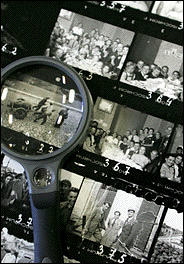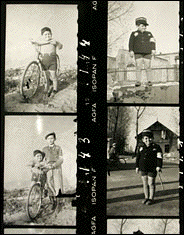.
Hesitantly,
Holocaust Survivors Revisit Past
By
LIZETTE ALVAREZ
Published: January 18, 2005
[Correction
Appended]
LONDON, Jan. 17
--The survivors of the Lodz ghetto held their magnifying
glasses close to the photographs and fixed their eyes on
each enlarged image, searching for a familiar face, a
recognizable building, a known street.
"I am trying to
find someone I know," said Esther Brunstein, 76, a native
of Lodz, Poland, who lived in the notorious ghetto as a
child from 1940 to 1944, before she and her mother were
taken to the Nazi death camp at Auschwitz. Of the more
than 200,000 people who lived in the Lodz ghetto, only 5
percent or fewer are thought to have survived the war.
"Here, look," she said, "someone is selling something on
a scale, perhaps a little medicine, a little
food."
"But I won't look
at many more," she said as her magnifying glass rested on
the face of a beaming toddler. "You see, when I see the
face of a child like this, and then you know he did not
survive."


|
..
|
|
As
the official photographer of the
German-supervised Jewish Council, Henryk Ross
was able to capture scenes of the seemingly
contented ghetto "elite," or Jews who held
coveted jobs.
[Photo: Jonathan Player.}
|
Arrayed before
the survivors for a private viewing on Sunday was the
largest collection of images of ghetto life during the
Holocaust by single photographer, Henryk Ross. Mr. Ross,
an official photographer of the Jewish Council, the
ghetto's German-supervised administrators, lived in Lodz
for years and chronicled its daily life. As the Germans
prepared in 1944 to round up most of the ghetto residents
for deportation to Auschwitz, Mr. Ross buried his 3,000
negatives. While his photographs include more familiar
images of the horrific aspects of ghetto life, because of
the nature of his job they also show less frequently seen
scenes of the seemingly contented ghetto "elite," Jews
who worked as ghetto supervisors and police officers or
held coveted jobs.
These latter
pictures are at the heart of Mr. Ross's collection and
raise difficult questions about the tiny minority of
people in the ghetto who lived relatively privileged
lives amid mass deprivation and were reproached, some as
collaborators, after the war. Among them are Chaim
Rumkowski, the feared and despised leader of the Lodz
ghetto's Jewish Council.
"It was a very
complex society, and a class system existed," said Janina
Struk, who was at Sunday's gathering and is author of
"Photographing the Holocaust: Interpretations of the
Evidence" (Chris Boot, 2004). "We are seeing a people who
had to survive, who had birthday parties, who took photos
of each other. We are so used to images of horror that
when you look at something different, it is easy to say
it's not true."
After the war, Mr.
Ross, who later emigrated to Israel and died in 1991,
retrieved his negatives, distributing a few of the most
ghastly images, which served to document the atrocities
of the time. His son offered the collection to the
Archive of Modern Conflict in London in 1997.


|
..
|
|
The
photographs of the elite or the "protected
class," as the survivors called it, were the
most striking in their departure from the stark
pictures typically associated with the
Holocaust.
[Photo: Jonathan Player.}
|
The collection,
aside from 100 images published last year in "Lodz Ghetto
Album" (Chris Boot), had never been seen by the public
until Sunday, when six survivors of the ghetto, along
with a few relatives and academics, gathered in a room of
the National Portrait Gallery here to search for
recognizable faces and discuss their
impressions.
Helen Aronson, 77,
who lived in the ghetto from 1942 until its liberation by
Soviet troops in January 1945, planted the idea for the
meeting after she spotted her boyfriend in a photograph
in "Lodz Ghetto Album" three months ago at a Holocaust
commemoration ceremony.
"I know this man, I
know this man with the accordion," Mrs. Aronson recalls
saying as she looked at the image of young people
celebrating the arrival of Soviet troops in Lodz. "This
is my boyfriend, Wysocki Szlomo, my first
love."
Her daughter, who
was with her at the event, said: "Mum, look at the girl
sitting next to him. That is you. That is
you."
So
it was, and soon Mrs. Aronson called other survivors to
spread the news. They asked the archive for a viewing of
the collection.
The
fresh images, even after so many years, stirred a
labyrinth of emotions. The memories proved disquieting,
not only because some of the images recorded suffering,
but also because some showed the mundane and the
contented.
The two women
in the group seemed the most interested in scouring the
pictures. The four men seemed considerably more
reluctant. Aron Zylberszac, 67, who spent four years in
the ghetto and a year in labor camps, sat in his
wheelchair and avoided the task altogether.
"All of these
images are very much stuck in my mind," he said. "I still
have dreams every night, and photographs make it worse,
which is why I don't like looking at them. In the dreams
I am always trying to run away and always trying to hide.
It is so realistic, like it was all happening, and I wake
up in a sweat. I am completely wet."
As one image, a
photograph of a postage stamp, was projected on a screen,
Perec Zylberberg, 80, who is Mrs. Brunstein's brother,
recognized himself. The stamp, of the internal ghetto
postal service, included a photograph of him working
behind a loom. "I am there," he said, nodding.
Mrs. Aronson picked
out another familiar face, a young man holding a rabbit
and staring into the camera smiling. "He was my friend,"
she said, "and here is his family."
As the official
photographer, Mr. Ross, along with his colleague Mendel
Grossman, was directed to catalog everyday
life.
The photographs
include images of tailors, cleaners, weavers and doctors
at work; of the hungry searching for food and ladling
soup into their mouths. There are also unauthorized
single frames of Jews being loaded into the cattle cars
that carried them to extermination and labor camps, a
corpse hanging from a noose in Lodz square, people
escaping from the hospital as the Germans rounded up the
sick, the old and the very young to send to their deaths.
Mr. Ross, academics say, risked his life to record those
scenes.
The photographs of
the elite or the "protected class," as the survivors here
called it, were the most striking in their departure from
the stark pictures typically associated with the
Holocaust. They featured smiling children in neatly
pressed clothes, sitting around a table laden with food
and drink for a party. A plump boy in a mini-policeman's
uniform, marching with his young friends around the
street. Revelers gathered on top of a horse-drawn
carriage.
"It looks like Nazi
propaganda," said Susanne Pearson, 76, who last saw her
parents in 1939, when she was taken to Britain as a
child. Her parents were sent to the Lodz ghetto, and she
never saw them again. "I know I will not find my mother
and father among them."
The former
residents of the ghetto held a complicated, decidedly
nuanced view of these images, and wavered between
bitterness and understanding. "We can't today judge
certain circumstances of Lodz ghetto and Rumkowski," said
Roman Halter, 77, who was among the last to be taken to
Auschwitz.
"I am very hurt and
bitter about the way the Lodz ghetto was run," Mr. Halter
said. "I lost my whole family in Lodz." But, he added:
"They were exceptional circumstances. And it is easy to
say now, 'He should have done this.' "
The elite
encompassed both the bad and the good, Mrs. Brunstein
said. A ghetto policeman saved her life after he spied
her and her mother hiding on a roof during a German
roundup and continued on his way.
"Hunger does not
bring out noble feelings," she said. "We knew it was a
hierarchy. They were privileged and they had more food.
If I had a chance, I would have taken it, too, depending
on the price."
For Mrs. Aronson,
the photographs touch a more personal chord. She was
indirectly a part of the elite, she said. Her father, who
she said died after trying to save the children of her
small town, knew Mr. Rumkowski and, because of that, Mrs.
Aronson, her mother and brother were given good jobs.
Hers was at an orphanage and later at a confectionary
factory. She was in Lodz until the war ended.
"To say that we
were privileged and that we knew we were going to survive
is a load of rubbish," she said, adding that she, too,
went hungry and feared for her life. "We had the same
rations as everyone else. My brother got from the Germans
a bit of food now and again. Food was the most important
thing to survive."
But survival, she
added, was never a given. Safety came only after
liberation, when, after hiding in a bunker with 15 others
for more than a week with a vial of poison in her
possession, they heard Russian voices.
Shortly after, she
and her accordion-playing boyfriend sat down with
friends, pulled out the accordion, and smiled for Mr.
Ross's camera.
Correction:
January 19, 2005, Wednesday:
Because
of an editing error, an article in The Arts yesterday
about a gathering of six survivors of the Lodz ghetto
at the National Portrait Gallery in London to look at
photographs of the ghetto misidentified the publisher
of "Photographing the Holocaust: Interpretations of
the Evidence" by Janina Struk, who also attended. It
is I. B. Tauris, not Chris Boot.
Copyright
2005 The New York Times Company
